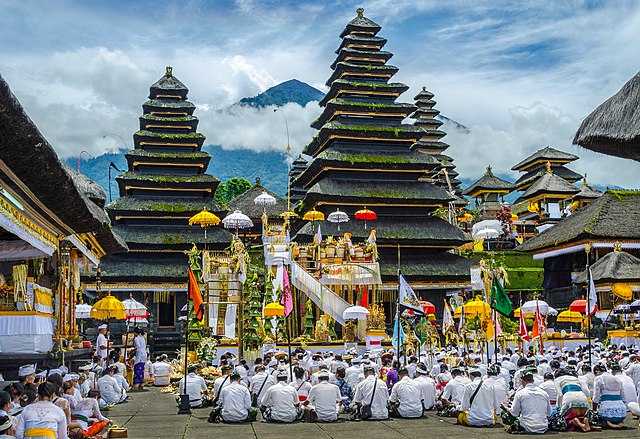Indonesia, a vast archipelago straddling the equator, emerges as a kaleidoscopic tapestry of cultures and religions. With over 17,000 islands and a population exceeding 270 million, it epitomizes a harmonious yet intricate fusion of beliefs, traditions, and practices. The dominant faith in this sprawling archipelago is Islam, but the spiritual landscape is embellished with Hinduism, Buddhism, Christianity, and numerous indigenous beliefs, each contributing its distinctive hue to Indonesia’s multifaceted identity.
In the heart of this religious mosaic lies Islam, the most widely practiced faith, embraced by approximately 87% of the population. The presence of Islam in Indonesia is akin to a resplendent river, flowing through the very fabric of society. Arriving through trade routes in the 13th century, Islam swiftly took root, intertwining with local traditions and norms. The rhythm of life here is punctuated by the call to prayer, a melodic reminder of faith echoing across bustling markets and serene villages alike.
Muslim practices are vibrant and diverse, illustrating the blending of local customs with Islamic tenets. Festivals such as Idul Fitri and Idul Adha are not merely religious observances; they are grand cultural spectacles, inviting communities together in feasting, prayer, and gratitude. These occasions encapsulate the spirit of togetherness, revealing a profound connection among individuals that transcends mere doctrinal adherence.
Yet, to view Indonesia through a solely Islamic lens would be to overlook the intricate patterns woven by other faiths. Hinduism, the second-largest religion in Indonesia, offers a captivating counterpoint to Islam. Predominantly practiced on the island of Bali, Hinduism retains a rich tapestry of rituals and mythology. The island serves as an oasis, where vibrant ceremonies breathe life into ancient beliefs. This island, often revered as a pilgrimage site for those seeking spiritual enlightenment or artistic inspiration, is adorned with intricately carved temples, echoing the call of the divine through offerings and prayers.
Hindu rituals in Bali and other regions stand out for their whimsical yet profound nature. The Balinese have turned spirituality into an art form; the vibrant colors of offerings and the perfumed air filled with the scent of incense create an ethereal atmosphere. Temples like Pura Besakih, often referred to as the “Mother Temple,” symbolize not only religious devotion but also a deep-rooted connection to the land and heritage. This synthesis of faith and nature reflects the intrinsic belief in harmony, resonating with the Hindu philosophy of dharma—living in accordance with moral law and duty.
As we navigate through this spiritual landscape, Buddhism emerges as another thread in the Indonesian fabric. Though it claims a smaller demographic, Buddhism finds its resonance predominantly among the Chinese-Indonesian community. The temples, adorned with golden statues and intricate designs, serve as sanctuaries for contemplation and reflection. Notable sites such as Borobudur, a monument to enlightenment, attract pilgrims and tourists alike. This UNESCO World Heritage site symbolizes a journey toward spiritual awakening, where the path to Nirvana is illustrated through countless carvings that tell the stories of the Buddha’s life.
Christianity, which represents approximately 10% of the Indonesian population, further punctuates this rich religious landscape. In several regions, particularly in North Sumatra, the islands of Sulawesi, and Papua, Christianity takes root through the efforts of missionaries in the 19th century, establishing churches that serve as beacons of hope and community. The manifestation of Christian faith is often marked by jubilant gatherings, hymns echoing through the valleys, serving to foster unity and resilience among its adherents.
Yet amidst all these grand expressions of faith, we must not overlook the indigenous beliefs that thrive in the interstices of the predominant religions. Local traditions manifest in numerous forms, from the dayak tribes in Borneo to the ancestral worship practices on various islands. These indigenous religions often emphasize a symbiotic relationship with nature, cherishing the wisdom of ancestors and the land. The rituals become a dance with nature, a conversation with the elements that underscores the importance of stewardship over creation.
In discussing the interplay of numerous faith traditions, it is crucial to acknowledge the delicate balance historically maintained in Indonesia. Despite moments of tension, the overarching narrative is one of coexistence. The fabric of Indonesian society, woven with threads of respect, tolerance, and dialogue, proves resilient against the strains of difference and dissonance. The nation’s motto, “Bhinneka Tunggal Ika,” meaning “Unity in Diversity,” underscores this ethos—a potent reminder of the rich variety in belief systems that can coalesce into a singular national identity.
From the majestic temples of Bali to the resounding calls of prayer from mosques, Indonesia serves as a living testament to the complexity and beauty of faith. The plurality of religions creates a vibrant dialogue among believers, shaping a national identity that honors both diversity and shared values. In this enchantingly diverse landscape, the search for truth, meaning, and purpose continues, revealing an indelible connection between the land and its people, faith and daily life, past and future.
As one traverses this land—each island whispering its own story—there lies an undeniable appeal in the spirit of the Indonesian people. They weave their beliefs into the very essence of life, drawing from a reservoir of cultural heritage. Through their eyes, one can witness a profound respect for the divine in myriad forms, offering a compelling narrative about the universal quest for understanding and connection in a world teeming with diversity.



